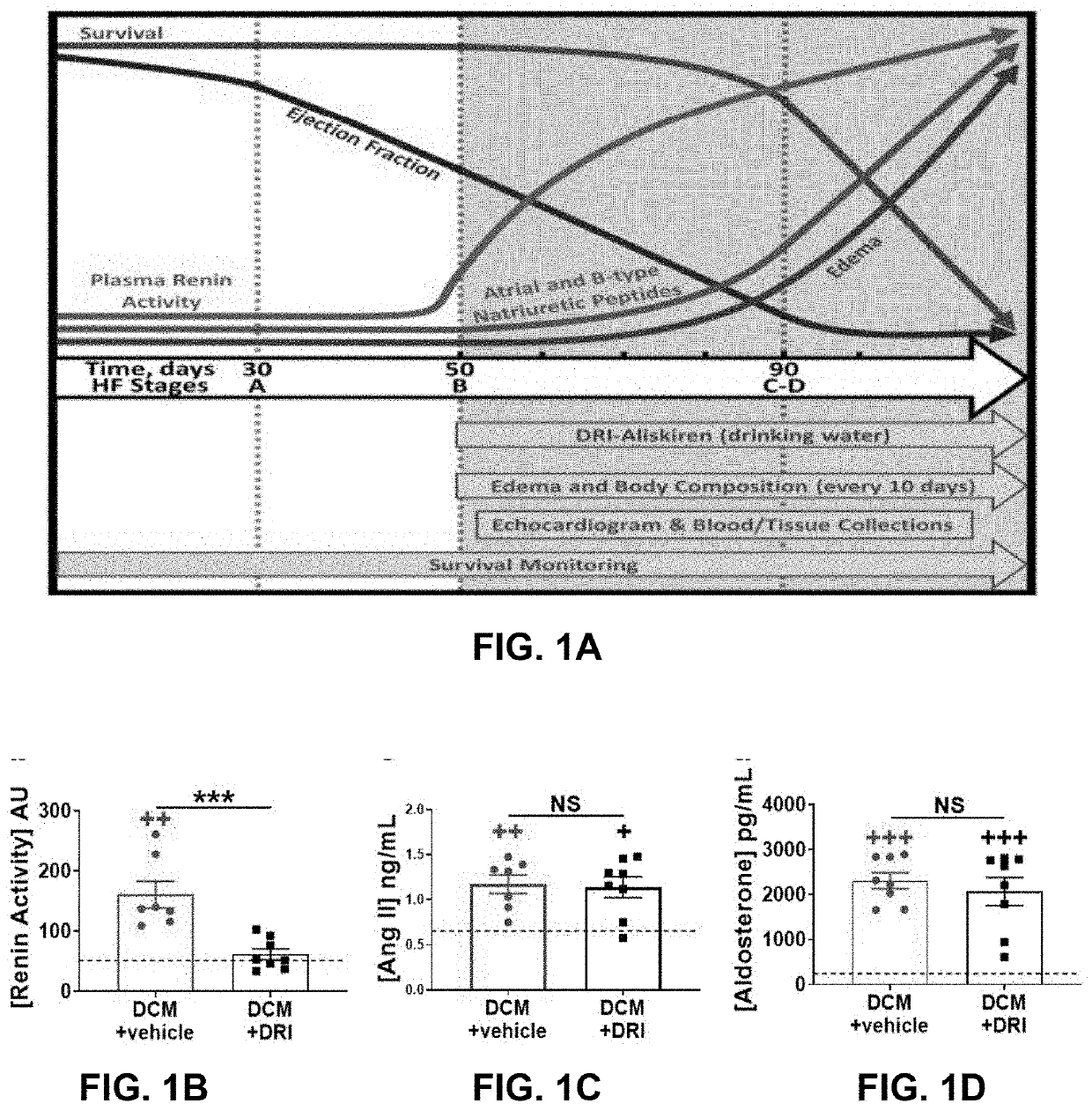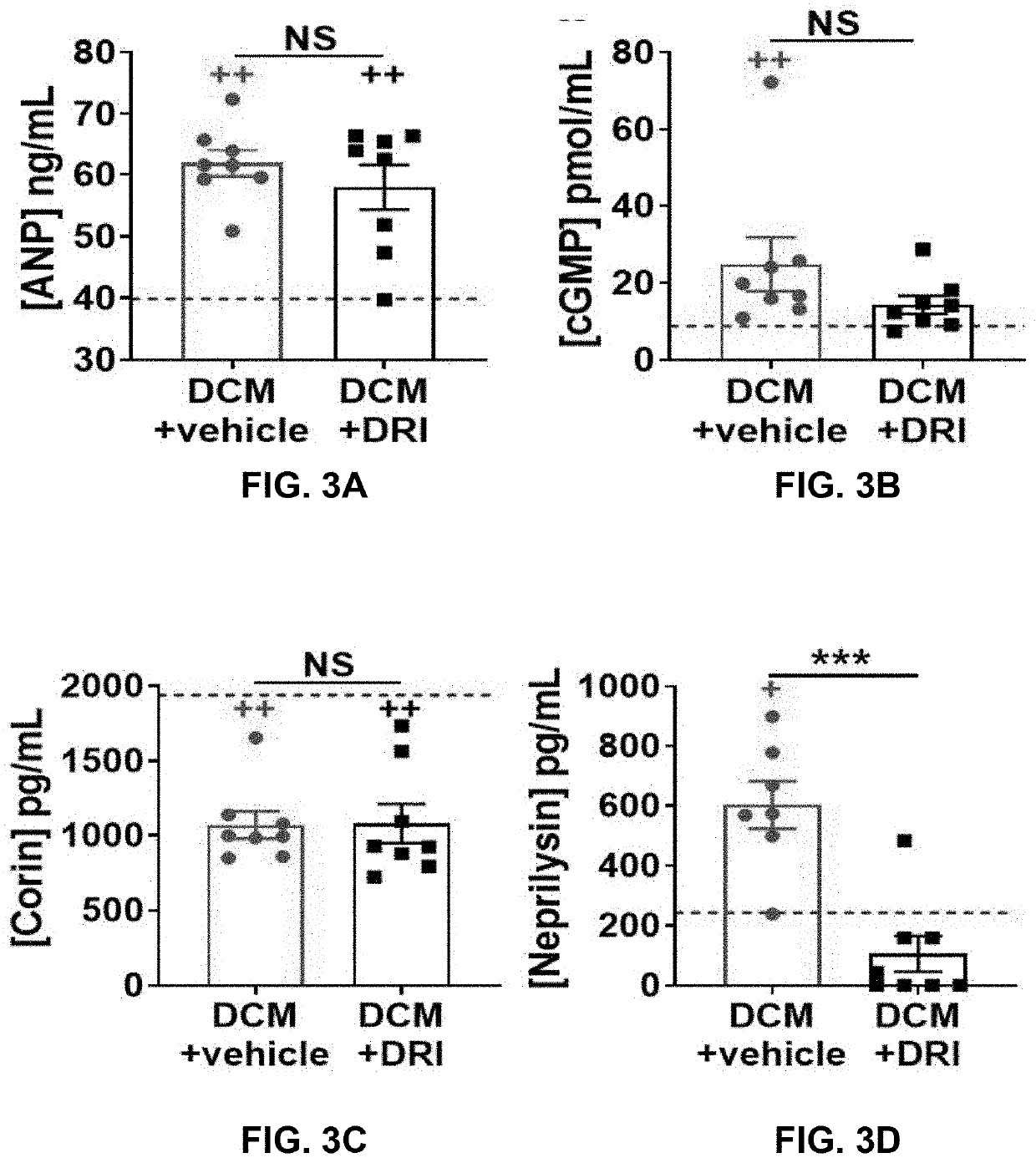Method of personalized treatment for cardiomyopathy and heart failure and other related diseases by measuring renin activity, pro-renin, pro-renin receptor levels in blood
a technology of renin activity and renin receptor, which is applied in the field of personalized treatment of cardiomyopathy and heart failure and other related diseases by measuring renin activity, pro-renin, pro-renin receptor levels in blood, and can solve the problem that clinical studies have not rigorously examined plasma renin activity in the pathogenesis of h
- Summary
- Abstract
- Description
- Claims
- Application Information
AI Technical Summary
Benefits of technology
Problems solved by technology
Method used
Image
Examples
example 1
on of Elevated Plasma Renin Activity in Females with Dilated Cardiomyopathy (DCM)
[0085]FIG. 1A shows HF development from Stage A (no HF), to Stage B (structural heart disease), through Stage C (edema, symptoms), Stage D (severe HF) and death. Female mice with DCM begin to show declines in heart systolic function (ejection fraction; EF) and increases in PRA around 7 weeks of age (Stage B HF), which is prior to the development of progressive edema, further declines in systolic function, rises in atrial / B-type natriuretic peptide (ANP / BNP) and death (FIG. 1A). Female littermate mice with DCM were randomly assigned to receive no treatment (control) or the direct renin inhibitor (+DRI) aliskiren. Treatment with the DRI significantly reduced elevated PRA to normal levels as expected (P<0.01, FIG. 1B). Pathologically elevated plasma aldosterone levels were not modulated by treatment (FIG. 1C). The aldosterone to renin ratio was significantly increased in +DRI mice vs. controls (P<0.05, FIG...
example 2
ivity Suppression Prolongs Survival and Delays Progression of Left Ventricular Systolic Dysfunction
[0086]The effect of plasma renin activity suppression was assessed in female mice with DCM as they pass progressively through the stages of HF development from Stage A (no HF), to Stage B (structural heart disease), through Stage C (edema, symptoms), Stage D (severe HF) and death. Three groups of female littermates were examined—DCM control, DCM+DRI and WT mice. WT littermates had 100% survival throughout the 140 day study (data not presented). +DRI mice outlived the control mice by 7% (median survival—110 vs. 103 days respectively, Pp=0.47. Pp=0.53, P<0.05, FIG. 2E) were positively correlated with survival outcome.
example 3
lure Plasma Biomarkers Independently Respond to DRI Treatment
[0087]HF biomarkers were measured in a subgroup of mice at 90 days. As expected, ANP (P<0.01, FIG. 3A) and cyclic guanosine monophosphate (cGMP, P<0.01, FIG. 3B) levels were elevated, while plasma corin levels were reduced (P<0.01, FIG. 3C) in control groups vs. WT littermates. ANP and corin plasma levels were not affected by DRI treatment (FIGS. 3A, 3C). Plasma cGMP levels in +DRI group showed a non-significant trend toward lower levels (FIG. 3B). Neprilysin levels were increased in controls compared to WT (P<0.05) and +DRI groups (P<0.001. FIG. 5D). DRI-aliskiren treatment lowered neprilysin to WT levels.
PUM
| Property | Measurement | Unit |
|---|---|---|
| time | aaaaa | aaaaa |
| rectal temperature | aaaaa | aaaaa |
| stroke volume | aaaaa | aaaaa |
Abstract
Description
Claims
Application Information
 Login to View More
Login to View More - R&D
- Intellectual Property
- Life Sciences
- Materials
- Tech Scout
- Unparalleled Data Quality
- Higher Quality Content
- 60% Fewer Hallucinations
Browse by: Latest US Patents, China's latest patents, Technical Efficacy Thesaurus, Application Domain, Technology Topic, Popular Technical Reports.
© 2025 PatSnap. All rights reserved.Legal|Privacy policy|Modern Slavery Act Transparency Statement|Sitemap|About US| Contact US: help@patsnap.com



